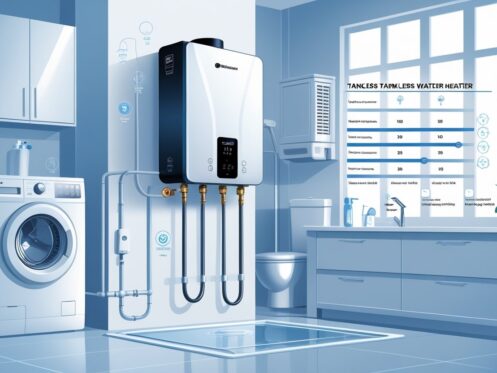Choosing the right size tankless water heater is essential for ensuring your home has a consistent supply of hot water. For most households, a unit with a flow rate of 6-10 gallons per minute (GPM) will meet the needs of your family effectively. The specific size you require depends on several factors, including your household size, peak water usage times, and the temperature of the incoming water.
If you’re unsure about the specifics, consulting a professional can help. At Splash Plumbing, we specialize in guiding homeowners through their plumbing needs, ensuring you select the correct size for optimal performance. Understanding your hot water demand will prevent any surprises, especially during high-usage times like morning showers or laundry days.
As you consider installation, remember that tankless water heaters are highly efficient and can save you money in the long run. If you’re ready to enhance your home’s hot water system, Splash Plumbing is here to assist you in making the best choice for your household needs.
Understanding Tankless Water Heater Sizing
Choosing the right size for a tankless water heater is essential for ensuring hot water efficiency and comfort in your home. Key considerations include how these units operate, the factors influencing their size, and the differences between gas and electric options.
How Tankless Water Heaters Work
Tankless water heaters, also known as on-demand water heaters, heat water directly as it flows through the unit. Instead of storing hot water in a tank, they activate heating elements only when you need hot water, allowing for an endless supply. When you turn on a hot water faucet, cold water travels through pipes into the unit, where either a gas burner or electric power heats it. Because they don’t rely on a storage tank, these units can save space and energy costs.
Key Sizing Factors: Flow Rate and Temperature Rise
When sizing your tankless water heater, two critical factors to consider are flow rate and temperature rise.
- Flow Rate: This measures how much hot water you need at any given moment, typically in gallons per minute (GPM). For instance, a household may require a flow rate of around 4 GPM to support multiple fixtures simultaneously.
- Temperature Rise: This refers to the difference between the incoming water temperature and the desired output temperature. For example, if the incoming water is 50°F and you want hot water at 120°F, the required temperature rise is 70°F.
These numbers will help you select a unit with an adequate capacity to meet your household’s demands.
Differences Between Gas and Electric Units
When comparing gas and electric tankless water heaters, each has distinct characteristics that may influence your choice.
- Gas Units: Generally offer higher flow rates and quicker heating capabilities, making them suitable for larger households or higher hot water demands. They typically require venting for exhaust gases.
- Electric Units: Often easier to install and maintain, they are ideal for smaller homes or when energy efficiency is prioritized. However, they may not provide the same flow rate as gas units in some scenarios.
Choosing between these units depends on your specific hot water needs, energy source, and installation preferences. For tailored advice, consider consulting with experts at Splash Plumbing.
Measuring Your Household’s Hot Water Demand
Understanding your household’s hot water demand is vital to selecting the right tankless water heater. You need to measure the total flow rate of all fixtures, analyze peak demand periods, and identify how different appliances utilize hot water.
Calculating Total Fixture Flow Rate
Start by listing all hot water fixtures in your home. Common fixtures include:
- Showers
- Kitchen sinks
- Bathroom faucets
- Dishwashers
- Washing machines
Each fixture has a specific flow rate, typically measured in gallons per minute (GPM). For example, a shower may use about 2.5 GPM, while a kitchen faucet could range from 1.5 to 3 GPM. Once you list the flow rates, sum them to determine the total flow rate your household requires during peak usage times. For a family of five, this total flow rate will be higher than for a family of two, reflecting more simultaneous hot water needs.
How to Determine Peak Hot Water Demand
Peak hot water demand refers to the maximum amount of hot water your household needs at any one time. To determine this, consider the time of day when multiple fixtures are used simultaneously. For instance, this might occur when someone is showering while the dishwasher and washing machine are running.
To analyze peak demand, consider the highest flow rates from various fixtures that could be in use together. If three fixtures—like a shower at 2.5 GPM, a faucet at 2.0 GPM, and a washing machine at 2.5 GPM—are used concurrently, the peak demand would be 7 GPM. This information helps you choose a tankless heater capable of meeting your household’s maximum needs.
Identifying Usage Patterns by Appliance
Understanding how different appliances function can significantly impact your water heater choice. For instance, dishwashers often require around 1.5 to 2 GPM, while washing machines may range from 2 to 4 GPM. If you frequently run both simultaneously, this can lead to greater hot water demand.
Consider usage patterns during your typical day. If mornings are busy with showers and laundry, you need a heater that can handle high demand during that time. Taking these patterns into account helps ensure your tankless water heater from Splash Plumbing can efficiently meet your hot water needs without running out during critical times.
Assessing Environmental and System Factors
When selecting the appropriate tankless water heater, several environmental and system factors play a crucial role. Key considerations include the incoming water temperature, the specific geographic region, and the energy efficiency of your chosen model.
Understanding Incoming Water Temperature
Incoming water temperature directly affects the efficiency and performance of a tankless water heater. Most systems operate based on a specific temperature rise, which is the difference between the incoming water temperature and the desired output temperature. For example, if you need water heated to 120°F and the groundwater temperature is 50°F, the unit must raise the temperature by 70°F.
Utilizing a groundwater temperature map can help assess your area’s average groundwater temperatures. Understanding this factor will ensure that you select a unit capable of providing adequate hot water during peak usage times without overworking the system.
Accounting for Geographic Region
Your geographic region significantly impacts water heating requirements. For instance, if you reside in a northern region where groundwater temperatures are consistently lower, you will need a more robust system than if you lived in a warmer area.
The temperature difference can influence the sizing of your heater. In colder climates, look for units designed with higher BTU (British Thermal Units) ratings. Depending on your location, it might also be beneficial to consult professionals for installation. Companies like Splash Plumbing can provide expertise tailored to your specific needs.
Evaluating Energy Efficiency and Source
Energy efficiency is critical when selecting a tankless water heater. Models with Energy Star ratings signify better energy performance and lower operational costs over time. You should also consider the energy source of your unit. Natural gas typically offers higher efficiency than electric models.
Furthermore, look at flow rates measured in gallons per minute (GPM) for your faucets and showers to ensure your tankless water heater can meet your household demands. An energy-efficient system not only saves you money but also is better for the environment. Understanding these factors will lead you to make a more informed decision about your tankless water heating needs.
Selecting the Right Tankless Water Heater Size
Choosing the appropriate size for a tankless water heater is crucial for ensuring optimal performance in your home. Factors to consider include your household’s hot water demand, flow rate requirements, and the use of sizing calculators for accuracy.
Using a Sizing Calculator
A sizing calculator is a valuable tool for determining the right tankless water heater for your needs. These calculators take into account your household’s peak hot water usage, which is measured in gallons per minute (GPM).
For instance, you may find that a flow rate of 6-10 GPM is necessary for the number of fixtures and appliances that will be in use simultaneously. To use a sizing calculator effectively, gather information about your hot water needs—for instance, your shower, dishwasher, and washing machine requirements.
Many manufacturers provide online sizing calculators that can guide you through this process, helping ensure accurate results.
Example Sizing Scenarios
Consider a few common household scenarios to illustrate sizing needs. A small household of one or two residents may effectively use a heater with a flow rate of 6-8 GPM. In contrast, a family of four typically requires a heater with an 8-10 GPM capacity.
For larger families or homes with multiple bathroom facilities, selecting a system that exceeds 10 GPM can prevent water shortages during peak usage times. By evaluating your specific usage patterns, you can choose the right size and avoid problems associated with insufficient hot water supply.
Sizing for Different Household Types
Different types of households present unique requirements for tankless water heater sizing. For instance, singles or couples in a smaller home may find a compact model sufficient, while a larger family may need a more substantial unit.
If you have multiple bathrooms and require simultaneous hot water use, such as in a busy morning routine, opting for a larger system is vital. Additionally, if your household includes high-demand appliances like washing machines or dishwashers, ensuring that your selected model can handle these needs without delay is essential for comfort.
For tailored assistance in sizing, consult professionals like Splash Plumbing, who can provide insights based on your specific requirements. This ensures proper sizing and optimal performance for your tankless water heater installation.
Comparing Tankless Water Heater Models and Brands
When selecting a tankless water heater, it’s essential to compare various models and brands to find the right fit for your home. Key considerations include brand reputation, features, performance, and certifications. This section highlights popular brands, important features to evaluate, and certifications that ensure quality.
Overview of Popular Brands
Several manufacturers dominate the tankless water heater market. For example, Rheem and Rinnai offer reliable gas models known for efficiency and longevity. Stiebel Eltron specializes in electric tankless options, emphasizing compact design and high performance. Navien combines advanced technology with energy-saving features, making it a solid choice for eco-conscious consumers. Ecosmart focuses on affordability without sacrificing quality. Bosch is another reputable name, known for durable units suitable for various applications. Evaluating these brands ensures you invest in a product that meets your hot water needs.
Features and Performance to Consider
When selecting a tankless water heater, pay attention to heating capacity, typically measured in gallons per minute (GPM). For example, if you need to support multiple fixtures simultaneously, aim for units offering higher GPM.
Consider energy efficiency ratings, as higher efficiency models can reduce utility bills. Features such as remote control, Wi-Fi connectivity, and programmable settings add convenience. Additionally, some units have built-in safety features to prevent overheating and leaks. Choose models that fit your usage patterns, ensuring optimal performance.
Certifications and Reputable Manufacturers
Certifications can indicate quality and safety. Look for products with ENERGY STAR ratings, which signify superior energy efficiency. Other valuable certifications include those from the American National Standards Institute (ANSI) and the Underwriters Laboratories (UL), ensuring compliance with safety standards.
When exploring options, select brands with a strong track record in the industry. Reputable manufacturers like Navien, Rheem, and Rinnai have established themselves through years of positive customer feedback. It may be worth consulting professionals from companies like Splash Plumbing to guide you in making an informed decision tailored to your specific requirements.
Installation, Costs, and Maintaining Performance
Installing a tankless water heater involves several considerations that can affect your overall satisfaction and utility costs. Understanding these factors will help you make informed decisions regarding budgeting, working with professionals, and maximizing efficiency.
Budgeting for Installation and Operating Costs
The cost of installing a tankless water heater typically ranges between $1,300 and $3,700, depending on the unit and installation complexity. Factors influencing costs include flow rate requirements, the type of fuel used (gas or electric), and existing plumbing conditions.
Consider both upfront installation costs and ongoing operating expenses. Tankless water heaters generally offer better energy efficiency than traditional tank-style models, leading to reduced utility bills over time. However, ensure you budget for possible retrofitting expenses if your current system needs significant adjustments.
Working With Professionals: Plumbers and Electricians
Hiring qualified professionals is crucial for the successful installation of a tankless water heater. You need licensed plumbers and electricians with experience in installing these specific units. Working with Splash Plumbing ensures you receive expert advice and quality installation services.
Before hiring, discuss the specifics of your home, such as the number of bathrooms and peak hot water usage. This information will help technicians recommend the right size unit. Clear communication about costs and timelines fosters a smooth installation experience, keeping your project on track.
Long-Term Energy Savings and Maintenance
Tankless water heaters can significantly lower your energy bills due to their on-demand heating capabilities. They eliminate the need to keep a storage tank of heated water, which traditionally leads to energy loss. Regular maintenance is essential for long-lasting performance and optimal efficiency.
Recommended maintenance includes descaling the heat exchanger yearly to prevent mineral buildup and ensuring filters are clean. Additionally, verify all connections and components at least once a year to avoid potential issues. Routine checks can guarantee that you enjoy consistent access to continuous hot water with minimal interruptions.
Frequently Asked Questions
Determining the right size for a tankless water heater involves understanding flow rates and household needs. Below are answers to common questions that can help you make an informed decision.
How do I calculate the appropriate size for a tankless water heater for my home?
To calculate the size you need, start by assessing your peak hour demand, which is the maximum hot water your household uses during the busiest hour. Add up the flow rates (in gallons per minute) of all fixtures that may be used simultaneously, such as showers, sinks, and appliances. This total will help you identify the ideal tankless water heater size.
What are the guidelines for sizing a tankless water heater for a small to medium-sized family?
For a small to medium-sized family, a tankless water heater with a flow rate between 7 and 9 gallons per minute (GPM) is usually sufficient. This size typically meets the demands of multiple fixtures in use at the same time, ensuring hot water is available when needed.
Can a tankless water heater be too large for my home, and how do I avoid that?
Yes, a tankless water heater can be too large, leading to decreased efficiency and higher upfront costs. To avoid this, focus on your household’s specific hot water needs rather than opting for a larger unit. Choose a model that matches your peak flow rate without significant excess capacity.
What should be considered when choosing a tankless water heater to replace a traditional 50-gallon tank?
When replacing a traditional 50-gallon tank, consider your household’s hot water usage patterns. Compare flow rates and ensure that the tankless model can handle your peak demand. Additionally, evaluate the energy source (gas or electric) and installation requirements to ensure a smooth transition.
Are there specific size recommendations for a tankless water heater for a household of four?
For a household of four, a tankless water heater with a flow rate of at least 8 GPM is typically recommended. This capacity accommodates multiple simultaneous uses, such as showers and appliances, making it an ideal choice for maintaining hot water supply during peak times.
What flow rate is suitable for a tankless water heater in a residential setting?
In a residential setting, a suitable flow rate generally ranges from 6 to 9 GPM. The exact requirement depends on the number of fixtures used concurrently. Choosing the right flow rate ensures efficient and consistent hot water delivery throughout your home.












